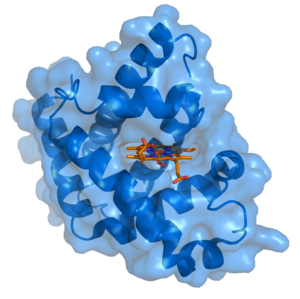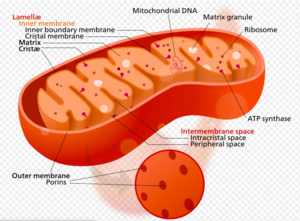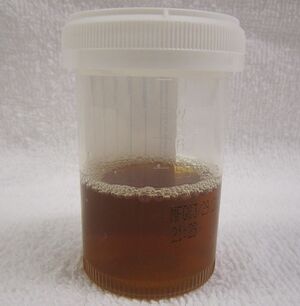Myoglobin
Original Editor - Lucinda hampton
Top Contributors - Lucinda hampton
Introduction[edit | edit source]
Myoglobin (Mb) is an iron-containing heme protein that is present predominantly in the sarcoplasm of skeletal and cardiac muscles. Due to the presence of heme moiety, myoglobin serves as a carrier and store for oxygen in muscle cells of the body. Myoglobin has more affinity for oxygen as compared to hemoglobin. As a result, it can acquire oxygen from hemoglobin, hence transferring it from the blood to the muscle tissues.[1]
IMAGE 1: Cartoon representation of Myoglobin (blue) with heme group (orange)
Here is the basic information Mb.
- It is a low molecular weight oxygen-binding heme protein and is one of the most important proteins in the human body.
- Mb is synthesized inside muscle cells. It "stores" oxygen there for use at times of high metabolic demand.
- It is mainly found in the heart and skeletal muscle cells, occurring in the highest concentration in the striated muscles of vertebrates.
- In skeletal muscle it serves to transport oxygen from the cell membrane to the mitochondria.
- Diving mammals such as seals and whales are able to remain submerged for long periods because they have greater amounts of myoglobin in their muscles than other animals do[2].
The effect of endurance training on myoglobin concentrations[edit | edit source]
Aerobic workouts and endurance training trigger important metabolic changes in muscle tissue, including an increase in mitochondria and the protein myoglobin. Mitochondria (the powerhouses of the cells) are necessary for creating ATP for energy. Myoglobin, on the other hand brings in the oxygen needed for that process, improving the aerobic capacity of muscles[3].
Myoglobin Testing[edit | edit source]
A myoglobin blood test may be used detect muscle damage. When heart or skeletal muscle is injured, myoglobin is released into the blood. Blood levels of myoglobin can rise very quickly with severe muscle damage and can be measured within a few hours following an injury.
Myoglobin is filtered from the blood by the kidneys and is released into the urine. Sometimes, a urine test is used to evaluate myoglobin levels in people who have had extensive damage to their skeletal muscles (rhabdomyolysis). Urine myoglobin levels reflect the degree of muscle injury. It may be ordered when there has been extensive injury to skeletal muscle, resulting in the rapid breakdown of muscle, and damage to the kidneys (tubular obstruction and acute kidney injury) from excess myoglobin in the urine[4].
If rhabdomyolysis has occurred due to rigorous exercise, the patients should be educated to modify their exercise routine and intensity. They should also be advised to maintain proper hydration during their activities and warned of the effects of dehydration[1].
IMAGE 3: Urine from a person with rhabdomyolysis showing the characteristic brown discoloration as a result of myoglobinuria
References[edit | edit source]
- ↑ 1.0 1.1 Anwar MY, Gupta V. Myoglobinuria. StatPearls [Internet]. 2021 Feb 6.Available:https://www.ncbi.nlm.nih.gov/books/NBK557379/ (accessed 23.11.2021)
- ↑ Biochem Myoglobin Available:https://biochemden.com/myoglobin/ (accessed 23.11.2021)
- ↑ Idsemergency management Myoglobin Available:https://www.idsemergencymanagement.com/2021/07/23/does-myoglobin-increase-with-exercise/ (accessed 23.11.2021)
- ↑ testing.com Myoglobin Available:https://www.testing.com/tests/myoglobin/ (accessed 24.11.2021)









